It is time that Chief Inspector Evariste Clovis Désiré Pel had a Wikipedia biography along with Jules Maigret, John Steed, James Bond, Lois Lane, and Xena.
He appeared full grown like Athena in 1979 (‘Death Set to Music’), Pel has had a long career in crime, crime-fighting, that is. the last outing was in 2002. His biographers have been John Harris, writing as Mark Hebden, succeeded by Juliet Hebden. Pel was a child during the German occupation, ten or less.
We shall start with that name. It is a cross to bear for Monsieur L’inspecteur Pel, who cringes whenever he is asked for his full name, say when renewing the driver’s license. In reply he hunches and mumbles to limit the number who hear. Three forenames is too many and none of them is particularly masculine, but the worst part is the third, Desired One — Désiré — a name usually reserved for girls.
His second most important characteristic is that he is in, for, and of Burgundy, and if possible never leaves it. Ever. Beyond Burgundy is, well, France (with the cesspit that is Paris) which is a foreign country to Pel, and beyond France lies darkness. In his moments of calm, few as they are, Pel savours Burgundy as Eden on earth. The trees, the patchwork fields, the stone farms houses, the blue tiles on roofs in the capital, the Palais de Ducs, the mellow yellow sun, the cuisine, the wine, all is perfection. He positively sings its praises, in his mind.
He is to the core a flic, and nothing but. ‘You’re nicked, you slag,’ snarled by Inspector Jack Regan would warm Pel’s heart. He would not understand the idiom but he would grasp the music of it immediately. Pel has risen through the ranks from the uniform service, where he stood in police lines while students from rich families threw rocks at him personally; and these students are now lawyers and doctors who fiddle their income tax, he is sure. Here is another Pel characteristic. He takes everything personally. From thence to Detective Sergeant, Inspector, and Chief Inspector. In the later role he has ten detectives to direct.
We meet Pel in his forties, he is short, slight, nearly bald with a few wisps of mousey hair, near-sighted with reading glasses pushed up on this head. Whatever clothing he dons at home, by time he arrives at the nick he looks like a hobo just off the rails. Even his best blue suit, the one he bought against the day, which day has not yet to come, when he receives a Légion d’Honneur from the President of France, becomes stained, creased, begrimed, and baggy as soon he takes it out of the dry cleaner’s paper. By the time he gets to the office, it looks like a sleeping bag gone wrong.
He is completely and totally addicted to Gauloise cigarettes, of which he smokes at least a pack of twenty a day, living in constant dread of running out, while promising that each one will be the last. Blind panic the strikes him when the prospect of running out arises.
Pel is an Olympic worrier. He mostly worries about his health. Those cigarettes! If he passes a person in the street who coughs, Pel is instantly paralysed with the fear that he is about to catch a mysterious mortal disease. Dr. Minit has long grown tired of his panics and laughs at him while offering a drink, thus confirming to Pel’s mind that he has little time left since the quacks never say if it is bad news.
If he is out of the office for long, he worries that the Police Judiciare will collapse without him, and so he is a frequent nocturnal visitor to the office. He is a lousy driver because he is always thinking about his cases or his health.
Despite squirrelling away in the bank nearly every franc that has come into his possession, he fears a life of penury, the more so when he retires on a police pension. This worry is despite the bank manager’s comment that Pel has a fortune in his account. He also fears he will be forced to retire all too soon since he is neither liked nor respected, and he does not understand the computer system that is coming online.
By some dark Faustian bargain, he has a live-in house keeper, one Madame Routy who exercises a domestic tyranny. In all of Burgundy she is the only person who cannot cook. She serves up sludge, called stew every night, which more often than not it is his only meal of the day. Worse, she watches television all day and all night with the volume at thunderous plus. Will his shabby house vibrate itself into destruction? He abides because he dares not rebuke her. She might quit and where else could he find a house keeper to live in his dilapidated house and work for the meagre pay he can offer. Moreover, her nephew Didier comes to visit sometimes and Pel likes Didier. When the boy grows up and enters the police service, Pel swells with pride before breaking into a sweat at the thought of all the dangers that will afflict Didier as a constable.
At the PJ he runs a tight ship. Few words of praise escape his lips. Requests for time off are met with ‘Non.’ He is bitterly jealous of his senior sergeant Darcy’s easy way with women, and positively livid that Darcy always appears to have just stepped out of fashion magazine, even when Darcy has been up all night on surveillance. So livid is Pel that to make himself feel better he searches for some fault to criticise in Darcy. He is even more angry because nothing he says phases Darcy who shrugs it off.
Pel loathes Sergeant Misset who combines being lazy with being stupid to a high order, but Pel can find no way to shed him from the squad where he spoils everything he touches. Pel bears a lifelong grudge against the traffic division which arranged for Misset to be transferred to his squad.
Then there is young Nosjean, the impoverished Baron de Troq, Lagé, the soon to retire Krauss, Claudie Darel whom he is sure will take his job away from him because she is terrifyingly smart, and then there is the Lion of Belfort who leaps into action at light speed: Annie Saxe, who is called La Lionne de Belfort for her mane of red hair and her origins in Belfort where there is gigantic statue in red sandstone of …. [Go on, guess.] Yes, a lion!)
Pel is a very effective officer, calm, decisive, and confident. In a crisis he knows what to do and how to do it. He rattles off brisk orders that give each officer a task and knits them together into a concerted action. While bemoaning his ill health, he works younger men and women into the ground.
Often he prefers to watch and wait, withstanding bureaucratic, political, and media pressure to act. His steely resolve in such circumstances inspires the members of his team, while he assumes they despise him.
He speaks a passable English. His father insisted that the children, Pel and his two older sisters, learn English on the assumption they would go into the wine business. Though he overflows with all the prejudiced stereotypes about the Les Rosbifs, he sits in a ‘comfort anglais,’ drinks scotch, and savours Yorkshire pudding on occasion. His one effort to prepare Yorkshire pudding bore a passing a resemblance to the Battle of Somme, such destruction did it leave in the kitchen for Madame Routy’s return!
His solitary life is lightened by the interest of the widow Madame Geneviève Faivre-Perret who seems to enjoy his company. Darcy was instrumental in their liaison and occasionally has been known to observe their affair with an bemused smile. While Pel is desperate for Madame, he is also terrified that he cannot afford to marry, to go out to dinner at a good restaurant, to buy a new car, to move house, and he cannot possibly change, much as he would like to do so. He worries himself sick about telling her his whole name!
He tries many things to please her, most of which backfire. He is as tongue-tied and confused as a teenage boy where she is concerned. All of this seems to amuse her still more. His daily resolve to quit smoking takes on an added urgency because he is sure she disapproves, and the fact that she has never said so, that being the final proof! His efforts to quit smoking are many and useless.
Pel has no interest beyond policing and so Darcy speculates on what Pel could find to talk about with Madame Faivre-Perret. By the way, Darcy lets Pel’s frequent bouts of bad temper slide off without reaction, which often infuriates Pel all the more. Pel is indeed irascible.
Pel sometimes dreams of being a Maigret, stolid, implacable, all-knowing, infinitely patient, imperturbable with a Madame Maigret to give him coffee on 3 a.m. call-outs and fill him with delectable home cooking. Ah… He entertains this fiction most often when swaddled in all the wool clothing he has, looking like the Michelin man, standing a midnight watch on a windswept hilltop in a January winter where the temperature is sub-zero and the gale is Siberian, or perhaps Arctic. Worse, the wind makes it impossible to smoke! Another of Darcy’s annoying characteristics is that he does seem to mind the weather — hot or cold, wet or dry — as he waits it out next to Pel.
Author: Michael W Jackson
It’s the economy! Again! And again. And again.
Every day for the last fifty years the Australian economy has been on the verge of collapse.

Not a week goes by but that the financial media offers dire warnings about increasing house prices, falling house prices, the high value of the Australian dollar, the low value of the Australian dollar, disastrous pay raises, long overdue play raises, the flight of capital, the threat of incoming capital, the burgeoning public deficit, credit card victims, exploited workers, impossibly high interest rates, perilously low interest rates, and on and on and on and on.

The slightest change in the cost of shoes or rent of 0.001% is described as a ‘massive leap.’ Any increase is crippling and any decrease is devastating.
Ad nauseam, indeed.
‘Wolf!’ has been cried so loudly and so often and in such contradictory terms that I have developed lupinophobia. Figure it out, Mortimer.
While all this nay saying occurs, the GDP, the GNP, calories eaten, the Per Capita Income, life expectancy, population growth, household consumption, superannuation savings, they have all increased to historically high levels and far above that of 95% of the world’s population. Most people in the Lucky Country are lucky enough to live like kings and queens compared to most of the rest of the world. compared to a their grandparents, compared to the entirety of history.
My conclusion is that hysteria is the only register for the journalist, who is completely detached from reality. Alternative facts have long had roots.
Rupert’s Organs set another record
How low can Rupert go? Another new record.
I have noticed in the ‘Times of London,’ the ‘Wall Street Journal,’ and our very own ‘The Australian’ and no doubt Fox News (but I never watch fiction) that President Barry ‘Bomb ‘em’ Obama is now being sledged.
In an effort to suck up to the Blond Beast, and with Hillary Clinton sidelined, Murdoch Rupert’s organs are now devoted full time to blackening Barry Obama. [Get it?] The snide racism of that woman on Fox News, who has now gone to NBC to continue the bile, is not enough. (The business decision was no doubt that she would drag her audience with her to NBC in the main stream. How the mighty NBC has fallen.)
Now that Vladimir Putin is the Blond Beast’s best friend, Obama cannot be disparaged for being soft on Russia, so….
In a creative leap, the Organs of Rupert have decided — sit down — Obama is a closet, no not that, a closet Marxist! Yes, they have! It has been drumpeted as news, in feature articles, and one of the local hacks has slurred it out a keyboard in an op-ed piece. Piece, indeed.
Proof once again that there is no limit to hypocrisy. (Mitch McConnell has a long way to go to compete with this standard. Keep trying, Mitch! [He hasn’t got a chance, but it doesn’t hurt to see the pathetic clot try.] )
Hypocrisy yes, but hardly original. The Alt Right nut cases have been saying this for eight years. Or that he is an Islamic fundamentalist. Or an alien spawn. Or…… They cannot seem to make up their minds. Wait, ‘minds,’ maybe that is the problem.
But now the nut cases are in charge. H. L. Mencken was right.
Here’s a flash.
Putin and the Blond Beast will pair up as running mates in the next elections in each country.
Or, another:
The Blond Beast will sell, er, marry off one of his children to Putin to cement the alliance.
Hillary Hating, the bile continues.
The post-mortems of the 2016 presidential election in the United States flow. It is all so simple, no wonder the PhDs could not see it coming and still cannot see it going. She is a woman. End.
[Warning, this post is all text. The graphics I reviewed to illustrate Hillary hatred were all so crude and stupid I chose not to include them. They make the programming on Chanel7MATE look refined and cultivated.]
By some mischance I stumbled onto some Hillary Clinton hating web sites the other day. I was so stunned by the cancerous bile that I could not immediately click on with my mouse finger. I have since recovered from the shock of a head-on collision with the whacko sickos. A brief digest follows.
Hillary Clinton has sold nuclear weapons to North Korea. (Evidently she carried them to Japan in her luggage when Secretary of State, and ducked into Chinese submarine in Tokyo Bay to hand over the goods.) In return North Korea paid millions of dollars to the Clinton Foundation. This is the form for many of the fantasies. As if North Korea had millions, apart from counterfeit.
Hillary Clinton has secret meetings with the Elders of Zion to collect still more dosh for the Foundation. As per the protocols of the Elders of Zion these meeting have included a banquet of roasted Christian suckling babies.
Want to know who has funded and armed ISIS? Look no further than Hillary Clinton. She did it.
Ku Klux Klan leader found dead. Guess who did it!
That tornado that destroyed Smallville, she brewed it in her witch’s cauldron.
Bill Clinton went vegetarian for no other reason than to destroy the All-American junk food business. Who put him up to it? Guess! Hillary!
It turns out she plotted with the Russkies to hack into the electoral system and puff up her vote.
The home team lost in the state finals because of referee’s call, well, she paid off the ref to favour the other team.
No villainy is to small for this one-woman coven.
I will not identify the websites since I have no wish to encourage visits.
I stumbled on these when I noticed an angry rejoinder to some innocent remark on the Facebook post about her lead in the popular vote. How, I wondered, could anyone dispute this fact. Little did I know.
It goes on and on, but I don’t.
These fantasies are so absurd, it would take forever to unwind and refute them.
Conclusions that are not reached by evidence and reason, in any case, will not be amended by evidence and reason.
That there is not one scintilla of evidence to substantiate these claims, which is readily and freely admitted in some cases, and cited as the ultimate proof of her guilt. She is so nefarious and spectral that she leaves no evidence in the mirror. (Figure it out, Mortimer.)
Hating Hillary meets some kind of emotional need in the haters. So it seems given the intensity of the SHOUTS. Yes, they are frequently in capital letters.
However it is not limited to the lunar right but can also be found on the lunar left. The King Street socialists in Newtown, the ones who tape their rants and dire warnings to the street light posts failed to predict the U.S. election result. The old crystal ball is not what it used to be.
For months these semi-literate damnations, each more outraged than the last, denounced Hillary Clinton as a soulless golem who eats proles for lunch and sups with the military-industrial complex.
Coda: The mystery to me of her defeat it how someone so smart, so organised, so well prepared, such a master of the game, did not clinch the states necessary to get the electoral votes. Maybe she listened too often to Al Gore. No wait, surely no one listens to Al Gore.
‘Ich bin ein Berliner’
For years I have heard pygmies declare that ‘ein(e) Berliner’ is a pastry. This is said for the purpose of belittling Jack Kennedy’s use of the phrase, in a speech in Berlin in June 1963, and to deprecate him, too. A search on the web will produce many hits for examples. Enough to satisfy those easily satisfied.
Below is the index card he wrote to insert the phrase in the speech. Before pedants begin correction the spelling, note that it is phonetic and was jotted off in the car on the way to the podium.
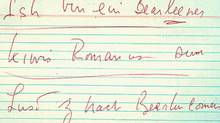
Once or twice I have bridled at this casual derogation, based on my own study of German, but that was always dismissed by the interlocutors.
Then one thing was obvious ,,, to those who looked. The Berlin audience in 1963 understood the phrase in the way Kennedy intended.
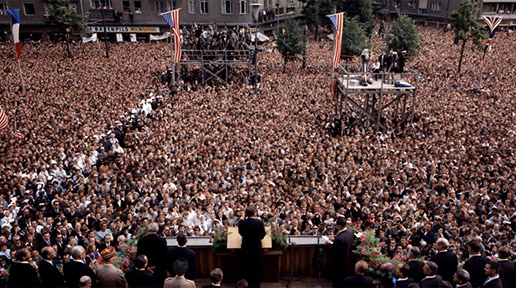 A crowd of 450,000 according to Wikipedia.
A crowd of 450,000 according to Wikipedia.
No PhD ever had such a reaction from such a mass of listeners. At the time, at the place it was a message received five by five, loud and clear. There is plenty of evidence on You Tube.


The other thing is that it is a grammatically correct statement as even a beginning students of the language know. I have had that confirmed many times over the years by German speakers, and again recently in the image below, taken from a Deutsche Welle website after a murderous attack in Berlin in 2016.
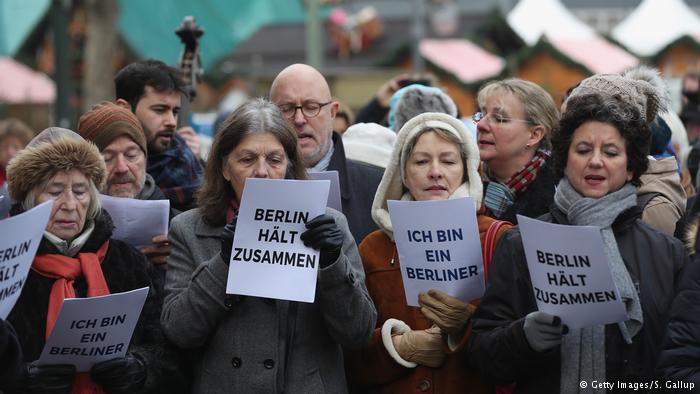
Perhaps the pygmies will now mock these two woman, too, while they bury their dead.
The attacks of pygmies on giants are endless, often petty, always trivial, and seldom accurate. The attacks satisfy some need in the pygmies.
No doubt some entrepreneur in Berlin has been marketing donuts with this meme for years. No doubt someone will offer alternative-facts. It was ever thus.
The other sign says ‘Berlin will hold together.’ Perhaps the best rendering is ‘Berlin will remain.’
Sydney Festival 2017
It’s a wrap for another year for us Festies. We went to five shows and found three winners, one curiosity, and the fifth.

In first place is Retro Futurismus. Whatever those Davy girls are on, there should be more of it! Followed closely by Ladies in Black. And showing, Measure for Measure.
That a mature Shakespeare plays came third is a surprise to us, too. But it was in Russian.
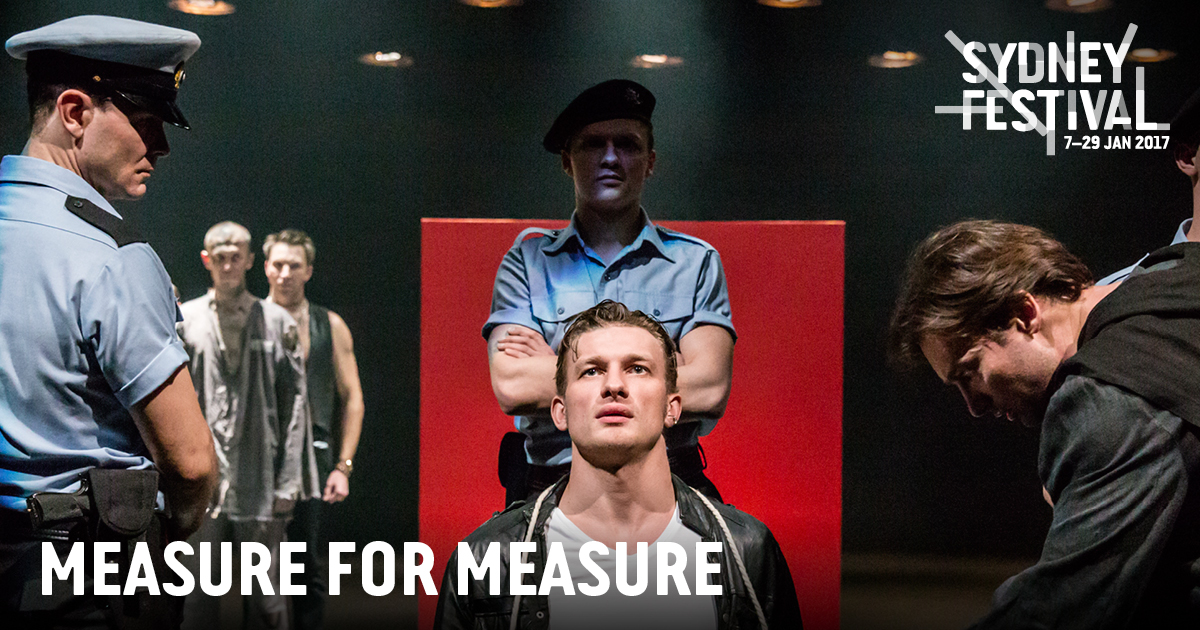
Ladies in Black was good as Goody’s should be. [The cognoscenti will get it, and hoi polloi won’t, and that is as it should be.]
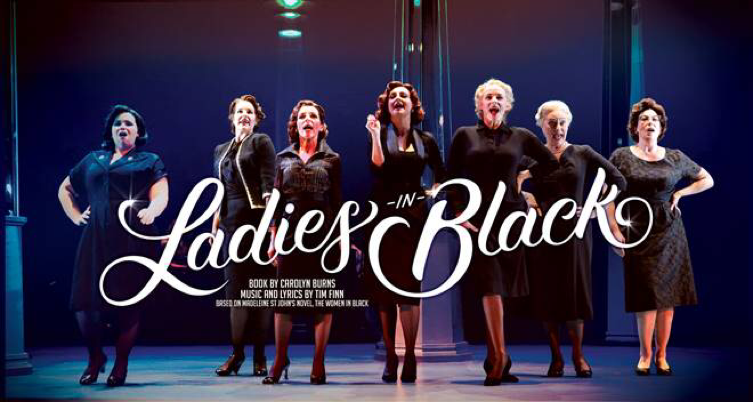
Retro Futurismus is genre-free and sometimes gender bending it is. Vaudeville one reviewer called it, and that will do. It is a variety show with some singing, some dancing, some wall climbing, some aerial without a net, a singing slinky, some ultraviolet light, and some more.

We found it amazing what can be done with bubble wrap, kitchen tongs, and house bricks. Strewth!
I am at a loss for words, except to say the next time Retro Futurismus puts on a show, I want to be there. The wit, the creativity, the energy, the bonhomie were all contagious.
Though I was intrigued by the description, i failed to list it when we consulted about our Festie this year. Why? Because it started at 09.45 pm, which is a good hour after I am in my pyjamas with a book in hand. But Kate said it was go, and so we went. She was right again. It was go!
We took an Opal bus each way and waited four minutes and nine minutes. The ride was twenty minutes. This I mention to indicate how easy and convenient it was.
Channel 7Mate and life.
During the United States football season I watch NFL games recorded on 7Mate. What an eye opener it is. No, I do not refer to the games, but to the advertisements, through which I fast forward at light speed. I try to do that but sometimes fail and when I do, I always regret it. Crass, vulgar, and stupid do not begin to describe the adverts, the products, and programs they promote.

The advertisements are for a demographic I know not, and I want to keep it that way.
The products usually promise the earth for $9.99, Hair growth for baldness, travel around the world for nothing, free tickets to this and that, invariably spectacles, like giant trucks crashing into each other, I never heard of and am glad of it. Many of the commercials imply there is a secret to getting these things, which will be revealed for a few dollars. Thus there are secret tricks to get first class travel for a pittance. Many concern weight loss, usually by eating. The suppressed premiss that there is a conspiracy known to others is a motif in many advertisements.
To say that the appeal of these commercials is simple and simple-minded is the kindest thing I can say. The smart people who identify and target the demographic of watchers (gulp, and that includes me) decide to do it that way.
More revolting still are the other 7Mate programs relentlessly advertised in breaks during the games usually described as bigger, louder, longer, ruder, and ever more …[tiresome]. Invariably they involve men doing stupid things while chortling about it.
Here is a sample:








Among the more respectable examples include farting contests, with ignition, projectile vomiting with a feminine twist. (Don’t ask!) Others involve crashing into immovable objects either headfirst or in vehicles of some sort. Then there were the urine drinking contests. Many of the adolescents filmed in these trailers are old enough to know better. Animal house with scraggy grey beards and one hundred word vocabularies.
At times the programs that feature these deeds, also have audiences cheering them on. Believe it or not.
Many other programs involve automobiles being lovingly stroked. or guns likewise stroked. What is it about stroking metal? Well whatever it is, I don’t get it.
Other advertisements for programs involve sweaty men playing with heavy machinery. They are not working for a business but rather wildcatting on their own. Ostensibly they might be digging for gold: X marks the spot. But really they are just having a high-ho time with a gigantic earth mover.
There are also movie trailers and they come from the same stable. Blokes killing CGIs. Computer Generated Images that is.
In every case the text is aggressive, belligerent, loud, and limited. Everything is a fight, a war, a battle, a contest. All those couch potatoes love watching others go at it. Even an auction is covered as if it were a fire-fight, as only those who have never been in a fire-fight could do. The men in the trailers, and yes they are invariably men, are usually unshaven, unwashed, or wearing greasy clothes, or the trifecta.
A few years ago Channel 11 of the Ten stable, showed the games and it was the same there. There is nothing exceptional about 7Mate except that I happen to see it.
Yes, I watch NFL games. It is the only United States sport free to air here, so it is the one I watch. I would prefer the NBA. I have given up on MLB because the players seem to lack fundamentals skills; the games are over-managed; and the commentary is so diffuse, oh for Vin Scully who was always interested in the game before his eyes, unlike those I last heard who were bored silly by the game and preferred to reminisce about dinners past. Maybe they are personalities who are feeding the twits who follow their tweets.
Jan Morris (1926+) née John Morris, ‘Venice’ (1960), Third Edition (1996).
A charming, enthusiastic, and altogether delicious memoir of life in Venice in the 1950s. It has an intimacy born of residence which goes into the details of everyday life, like rubbish removal, and the weekly shopping by dingy. Indeed, it includes many asides on the perils and joys of keeping a small boat for just such mundane purposes, and the surprising array of regulations and taxes that a humble, leaking rowboat attracts, watertight or not.

The Venice of the 1950s is gone, but Morris is confident that as long as there are Venetians there will be a Venice. The gene pool is strong, deep, resourceful, and clever enough to withstand the tides and times, Morris opines in the 1996 introduction to the reprint of the book, originally published in 1960.

The approach is almost ethnographic, as an anthropologist living amongst a tribe in the African savannah, he observes, notes, compares, enumerates, and ponders the meaning of what he sees, but with much more affable affinity than a Cambridge don in khaki kit roughing it for a few months in the jungle on the way to promotion. Morris spoke enough Italian to get to know the regulars he met, and enough to talk his way into some places not usually open to nosey beaks. He combines with those assets a keen eye and a tireless pursuit of detail that would satisfy John Ruskin. To these he adds a bonhomie that is hard to resist. Well, why resist it at all?
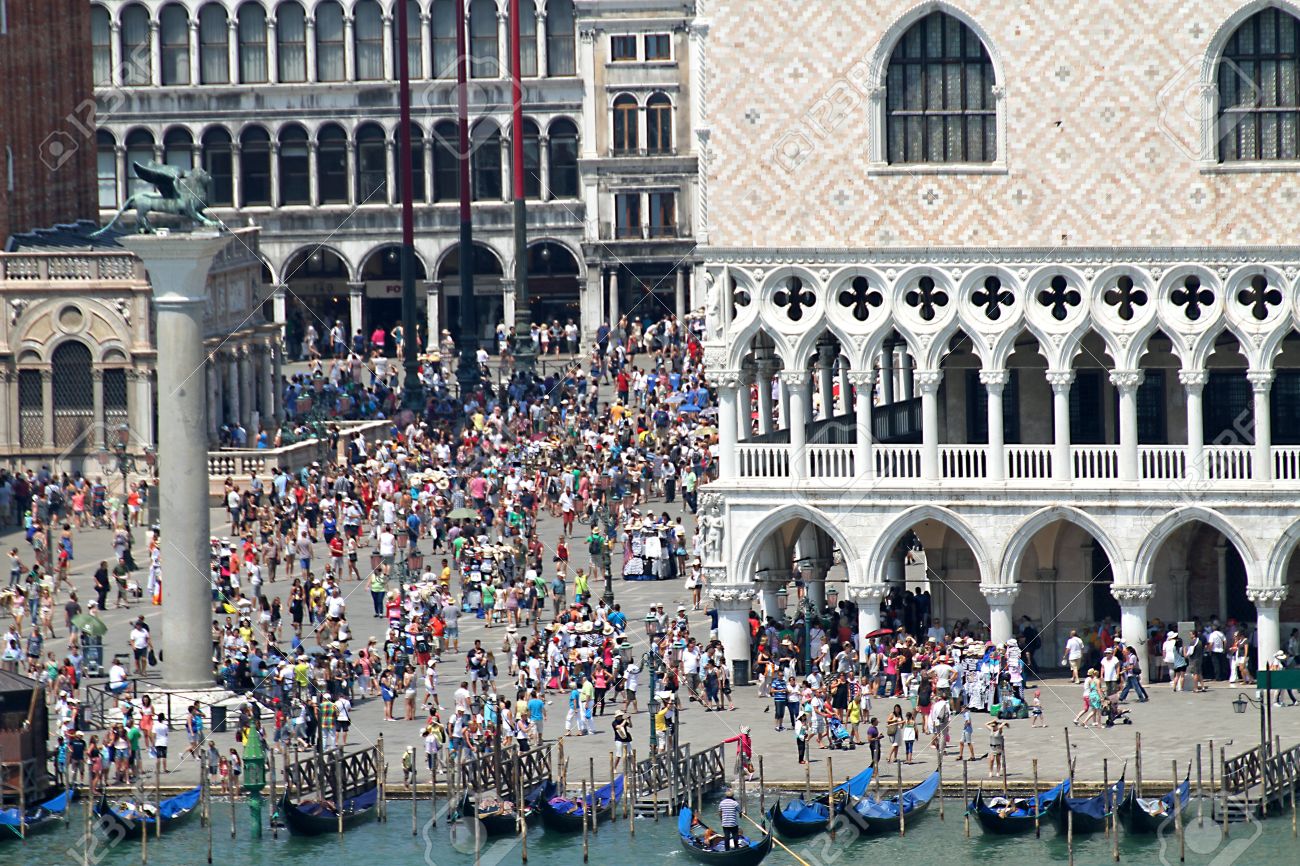 A quiet day at San Marco.
A quiet day at San Marco.
Day by day over the months Morris weaves together many asides on the history that brought Venice to the current point; these accounts often take the form of lists. That might sound boring, but it is not. Consider the following example as one of many instances.
Here is Morris’s dictation while standing on the tiny balcony of the flat there was:
‘To the left is the palace where Richard Wagner wrote the second act of ‘Tristan,’ and just beyond is the terrace from which Napoleon Bonaparte once watched a regatta. Near it is the house where Robert Browning died, that Pope Clement lived in it, the Emperor Francis II also stayed in it, and Max Beerbohm wrote about it. Across the way at that point is the home of the Doge Cristolo Moro, sometimes claimed to be the original of Othello, and to the right is a palace once owned by a family so rich that it is still called the Palace of the Money Chests. At the corner is the little red house of the poet D’Annunzio wrote ‘Notturno’ there. At the Convent next door Pope Alexander lived in exile from Rome. King Don Carlos of Spain once owned the next house along. La Donna of ‘La Donna è Mobile’ lived nearby. Away to the right, is a palace where one of Byron’s paramours suicided.’
All of this lies within one learned glance.
That is both a comment on how compact is the core of Venice, and also, and more importantly, a comment on what a magnet it has been for the great and good and the not so great and the not so good over the centuries. Yes, Adolf Hitler met Benito Mussolini there in 1934.
 Adolf Hitler and Benito Mussolini
Adolf Hitler and Benito Mussolini
Followed shortly by Indiana Jones.
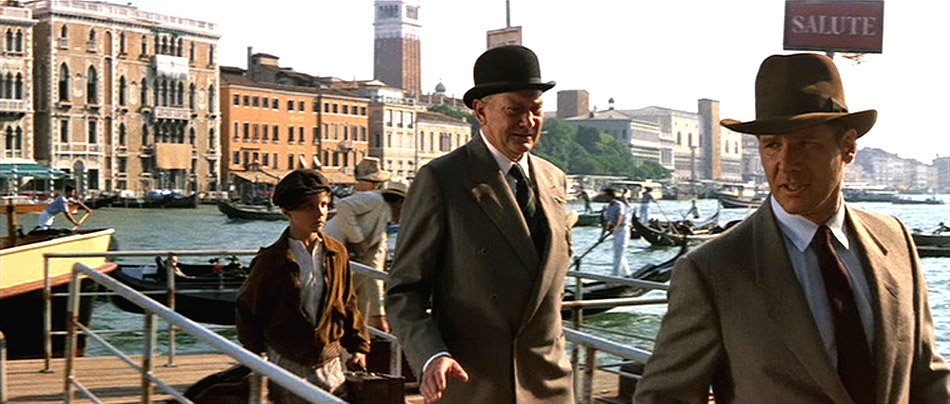
Morris goes on to enumerate and describe the many watercraft to be seen in the lagoon from towering cruise ships to garbage scows, to vaporetti and gondoli, and in many cases goes into the etymology of the terms in part to show the polyglot past of Venice with its Arabic, Islamic, Roman, Teutonic, and Byzantine influences, turning the catalogue into a history lesson, spiced by Morris’s own experiences in dealing with many of the craft as either a passing boatman, or as a passenger.
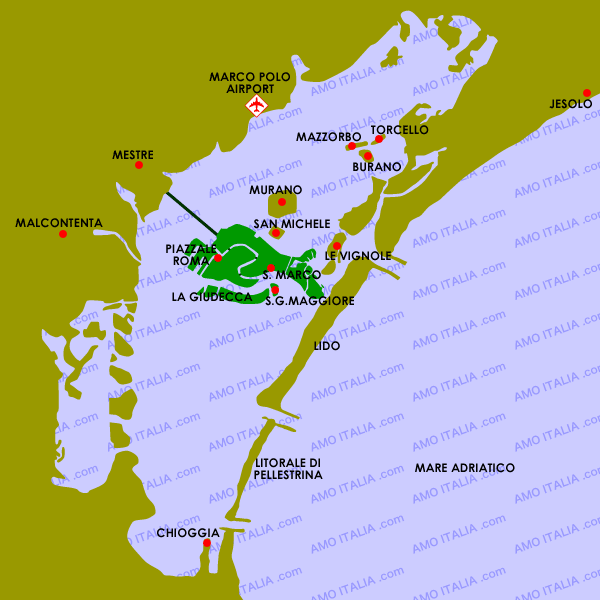
Venice conjures the gondola and Morris gives it due respect. Totemic though it is of Venice, there is no clear explanation of its origins, purpose, or use. Why does it have three notches in the bow? Why is it propelled by a pole and not an oar? Why is it painted black? While the number in the water has decreased by many factors, it remains in demand … by tourists. Morris offers a charming account of both past uses of the gondola and the occasions when contemporary Venetians make use of this clichéd but inevitable device.
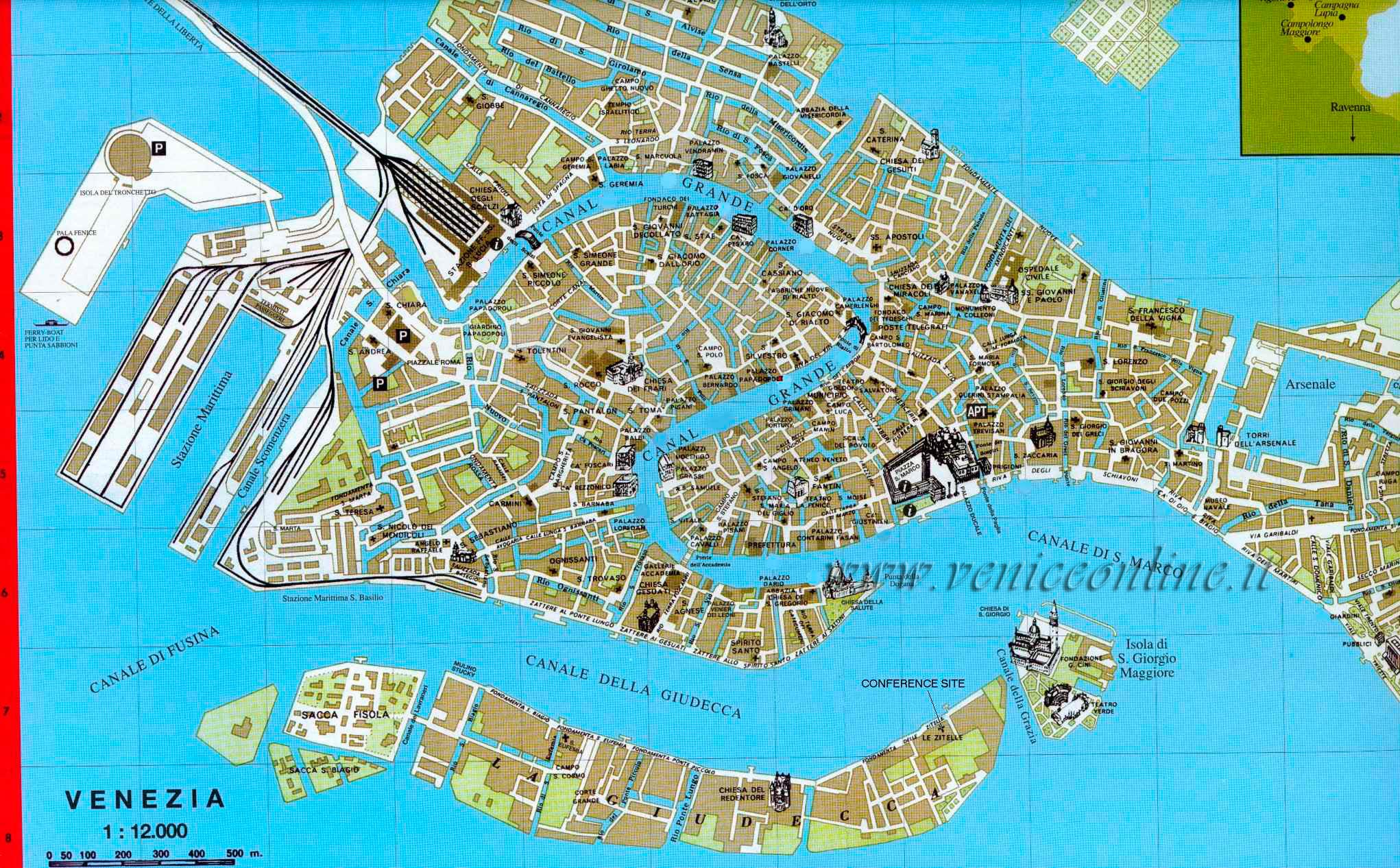
Like others who have written of Venice, Morris sees in it a deeply ingrained commercial imperative to make a living out of trade. Having no natural resources, Venetian has always been a broker bringing products to a buyer at a premium. The commodities that Venice can make a profit trading have diminished and disappeared, that is, all but one. The one commodity that Venice retains a monopoly on is itself, and so it trades on itself and does that to a T for Tourism.
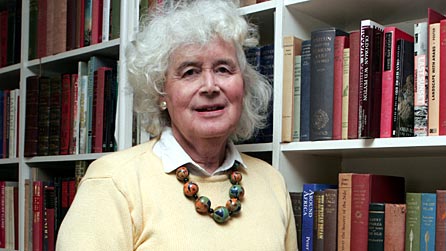 Jan Morris.
Jan Morris.
Upon completing the book, I am not sure what to make of it. To read it is to envy the author’s mastery of the exposition. This writer could make a recitation of a telephone book interesting, and indeed, did so in these pages. In some ways it is a memoir of a world now gone. As Morris found even while living in Venice human intervention changed the face of Venice time after time with causeways, channel dredging, factory building, and more, and also the lagoon itself makes changes, eroding what were once residential islands into little more than hillocks of sand.
But the more Venice changes the more it remains exactly the same! Grasping and enchanting, mercenary and magnanimous, seedy and edifying, grotesque and elegant, universal and unique, quite unlike any place else.
‘Measure for Measure’ (1604) by William Shakespeare.
We saw the Pushkin Theatre’s presentation of ‘Measure for Measure’ in Russian at the Sydney Festival. As homework, this inveterate student read the Folger Institute’s online version the morning before attending the evening performance. It helped a lot, having the major events and speeches in mind. The play had surtitles, which were easy to read, accurate to the play (as I recalled it from that morning’s reading), and also quick to keep pace with the action. Because I knew the play, I did not need to read every word of the surtitles, ignoring the players, to follow the action.
Originally classed as a comedy, ‘Measure for Measure’ is now canonised as a problem play. It is certainly serious as it touches on torture, rape, tyranny, hypocrisy, capital punishment, execution, and other problems that remain with us.
The Duke is tired of the responsibilities of office and curious to see what happens without him; off he goes on vacation, leaving Angelo in charge. Angelo is far more strict that the Duke, and becomes a scourge for Vienna. However, he is tempted to carnal knowledge by the beautiful and chaste Isabella. He will free her brother from prison and a death sentence if she will bed him. Her brother is guilty, by the way, of very same carnal knowledge of Juliet. The comic relief is provided by Lucio, a hanger on. There follow tricks and ruses in which everyone gets what they want, except Angelo, though he comes out of it pretty well. Most summaries refer to him as corrupt, and maybe he became corrupted, but he has a crisis of conscience at the beginning. He is no cardboard figure.
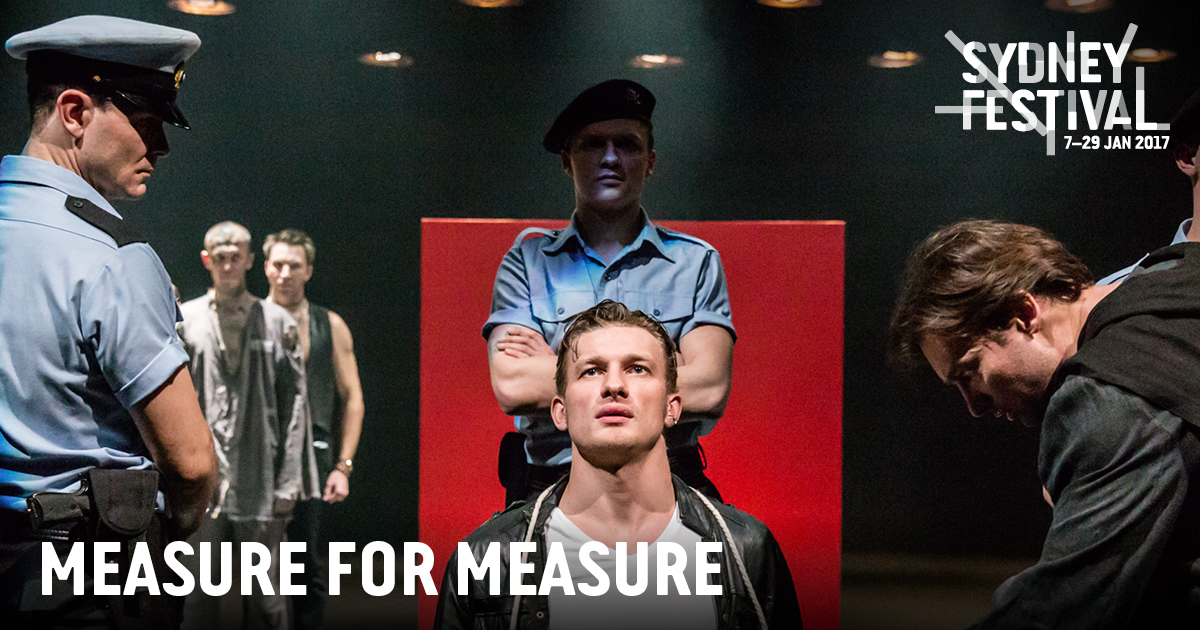
One might say the greater villain, if villain there must be, is the Duke himself who contrived the whole thing as an entertainment for his jaded eye. He manipulated the whole situation, and plays on the characters in Acts IV and V like puppets. At the end Lucio is sent to be hanged for slandering the Duke, whereas in this performance, which has edited the play down to 110 minutes, he is sent to be whipped.
The play is indeed the thing. The production was marvellous. Full of energy and light. It ran straight through with no interval which sustained the momentum and energy. An excellent approach. Changes of scene were marked by a swirl of the characters around the stage leaving upstage those in the next scene while the others retired to the position of a chorus looking on and occasionally reacting. The actors were on stage for the duration. Costume changes were effected behind the stage props, four red block that turned out to be….
We particularly like the first dance sequence between a blindfolded Angelo and Maria as Isabella. The bass playing makes sense after a few minutes.
There is a trailer on You Tube at
There are also some interviews with the producers and actors discussing the themes in the play.
It surely took some courage to include a Russian language production in a large theatre in the Sydney Festival. There must have been wise heads demurring all along the way. Too risky. Too outré. Too complicated. Too hard. Too…… too. No doubt I would have been one of them. Wrong. Chapeaux!
How easy it all was. I could command to the iPad screen the authoritative text of the play when I chose to do so. No trip to the library or bookstore to find all the copies gone. I printed the tickets at home so no queuing up. The surtitles worked perfectly to bridge the language barrier.
Moreover, we drove into the Rocks, parked at the front door of the theatre, ate a good dinner a few doors down the street, and walked back to the theatre for the show. To go home, it took fifteen minutes from leaving the theatre to entering the house. For that evening Sydney was like small town. The more so since we saw some people we know in the crowd.
‘Venice: Pure City’ (2009) by Peter Ackroyd
The book is an elegant and languid meditation on the city of Venice, the one in Italy not the one in California. It tells the story of Venice through thematic chapters rather than a sequential history. The chapters run ten to twelve pages, easily digestible in a sitting, and the segues from one to another and within each are smooth as the surface of a pond on a still day. Without a doubt the man can write. The book is replete with watery images, metaphors, comparisons, similes, and tropes. I felt moist reading it at times.
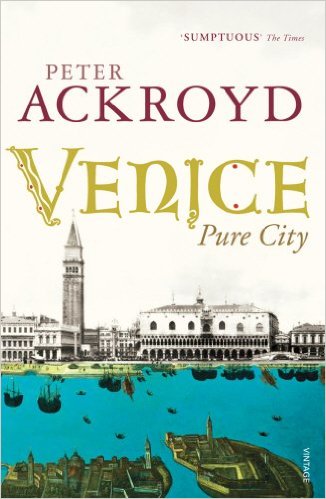
A sample of the chapters includes; Origins, Trade, Refuge, Stones, Chronicles, Secrets,…..
Leaving aside a myriad of details, the heart of Venice was and is trade. It made itself an entrepôt for more than a thousand years. Having no wealthy terra firma, having no mineral riches, having no vast population, it lived by wit, barter and trade. It became the European end of the Silk Road. The merchants Shylock funded sailed into the Black Sea and along the Levant coast to bring back to Venice the luxuries of the East and sold them in trade fairs in Venice. The first Venetian carnivals were commercial expositions.
During its long ascendancy, when violent change was the norm in other polities, precipitated from within by ambitions or ideologies or from without by invasion, Venice remained stable. The city lived with the constant threat alta aqua, which made Venetians pull together, however much they grumbled, like no others at the time. Until Napoleon in 1804 joined it to the Italian kingdom he created for his brother it had stood apart from one and from all. Having no choice Venice reluctantly and slowly became a part of Italy. Earlier when Niccolò Machiavelli rhapsodised of a future Donna Italia he did not include Venice in it, and in this he was not alone seeing it as an enemy of Italy, not a part of it.
In Venice the commercial imperative reduced everything to a contract, and copious records were kept which miraculously survived despite many catastrophes natural and human that often destroy the past. Ackroyd has immersed himself in the dry and dusty ledgers when not walking the campi and picked out some very apposite instances for the reader.
Venetians were traders for whom the sea was the highway. They bought cheap and sold dear and on the margin prospered. Though the merchants were private businesses, their activities were supported, encouraged, promoted, and taxed by the commune as a whole. To specify, the ships were built and owned by the commune and rented to merchants complete with crews. There is a parallel here to George Pullman and his famous railway cars, which are treated in another review on this blog.
Because of the historical and ever-present threat of the water the communal spirt ran deep, and lasted longer even in the age of Enlightenment individualism. In Venice the whole comes before the one. Else everyone drowns. The comparisons to Amsterdam are many.
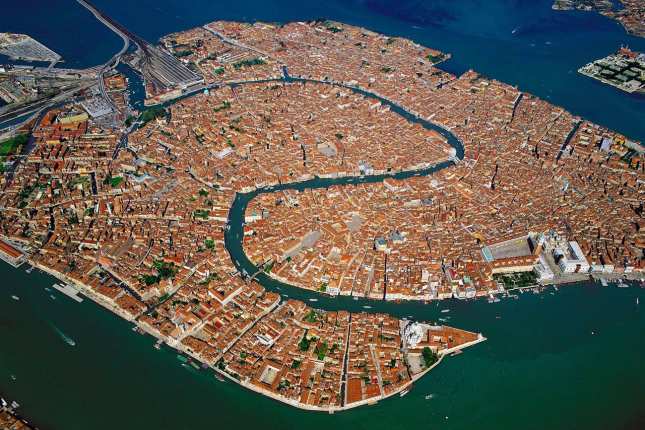
Like many others he is impressed by the Venetian drive for order and regulation, the more so in the face of repeated Venetian corruption, extortion, embezzlement, and fraud. Shylock was the least of the problem for most merchants of Venice. Ackroyd is absolutely deadpan in the chapter called ‘Merchants of Venice’ in which he does not mention William Shakespeare and his Venetian play. If he did, I blinked. Earlier he does mention Venice’s most famous literary tourist, Gustav von Aschenbach from Thomas Mann’s mediation on life and death … in Venice.
Everything was put down on paper, moreover, everything was kept totally secret. There is the paradox, everything was recorded, included the energetic informing on each other that kept the authorities busy processing, but nothing was said. Ackroyd cites some remarkable examples of the ability of Venetians to keep secrets. They make all those Stasi agents in the Deutsche Demokratische Republic (DDR) look like blabbermouths. There are many, and to this reader, surprising comparisons to be made between the DDR and Venice in matters of secrecy, security, and surveillance and the high cost of such social control.
In the case of Venice the campi — the residential squares — made surveillance unavoidable even for those few who were not interested in spying on their neighbours, and easy for the great many others who were interested. One result is the hidden doors of many houses, so placed to avoid prying eyes. Another result was the mask and cape.
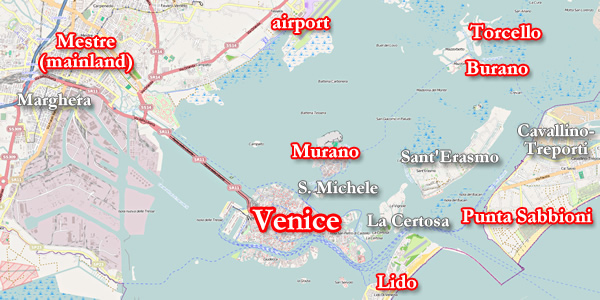
Yes, there is a ‘but’ coming. The book is all trip and no arrival. Though each theme is treated clearly and simply, this reader lost impetus. Without a sequence of events the reader has no characters upon whom to focus or chain of events to follow. Of course, the author’s choice to do that puts all the focus on the city of Venice and Ackroyd’s considerable powers of persuasion, and it kept me reading.
‘Doge’ is a dialect corruption of ‘duke’ and they come and go but none move the story on. Doges were invariably elevated at an advanced age, say seventy-two, and some then continued for another twenty years. There was an unbroken line of one hundred and twenty doges until Napoleon brought the Enlightenment on the bayonets of his army. The regime, in the terms of comparative politics, was authoritarian, oligarchic, patriarchal, and gerontocratic. That is for those who suppose labels are explanations. Napoleon, extracting a huge tribute from Venice, had the Golden Book of the Doges publicly burned. It was the genealogical register of the ducal families, the clan that sired the succession of doges, and its destruction completed the rupture with the past.
Venice was a republic; it did not have hereditary monarchs, though successful and powerful families strove for dynastic succession, and it did not have a feudal past in which a few owned the land and the landlord owned most people. The social strata were thus not the hard sediment they became elsewhere, but they hardened over the millennia. No gondolier ever became doge and no scion of the Golden Book ever poled a gondola.
Its foundation, existence, continuation, wealth, and stability depended on trade over the seas, and that trade required a great many skilled artisans to build, maintain, and repair the ships that were rented to merchants. The importance of these skilled craftsmen gave them more leverage in Venice than in many other comparable places. It is easier for the workmen at a single shipyard, the Arsenal, together to make their displeasure known than for an equal number of peasants scattered over vast estates to do so. See Gdansk in Poland for further confirmation.
The pages of the Golden Book represented about four percent of the population and the mercantile strata added another six percent, leaving the ninety percent out of the political, social, and financial elite. Those of the Golden Book tried hard to marry only within its own small ranks, and the merchants married their own kind when not trying to marry up. The total population in its prosperous times numbered about 100,000, more than it does today,
As with cities like Florence in the Fifteenth and Sixteenth Centuries, the government of Venice was complicated and convoluted, by design, not by accident. When problems arouse a committee to act on it would be created and it would inevitably perpetuate itself in the first law of administration — goal displacement — revealed in 1957 by Philip Selznick in ‘Leadership in Administration.‘ There grew an encrustation of such committees with vague and overlapping remits, that never seemed to lapse. They often worked in ignorance of each other even when they had overlapping membership the law of secrecy applied. While laws were written, they were never codified and seldom promulgated and enforced only when necessary. It sounds very much like a university Department’s approach to self-government in the days when that was tolerated.
This open texture might seem to offer many opportunities for citizens to play one committee off against another, as is commonplace today in organisations, but not so in Venice, because the existence of most of these committees was secret, so secret that other committees with exactly the same terms would be created anew, and all of their activities were secret, too, including from each other.
Of course, there was no written constitution that spelled out anything. Some of that may remind a reader of working in a large organisation without an organisation chart, and no reporting. Yet everything is recorded. Ahem, see the passing remark above about a university department.
In a way, though prima facie more formal with its archive, it reminded me of the rule by talk in Colin Turnbull’s ‘The Forest People’ (1961) where every instance is treated as unique and talk, talk, talk until the antagonists prefer to give way than talk anymore, like those self-governing co-operatives in the 1970s where everything was done at all-staff meetings that went on, and on, and those who persisted eventually got their way. It was self-management by verbal attrition. Compared to this, McKinsey management looks better.
The Venetian mask a perfect metaphor for the pure city. It is ‘pure’ by the way because it had for most of its history no hinterland with apologies to Padua. It was all city and nothing else. While Florence had a rich agricultural land in its domain, where the Medici family raised beef cattle that still grace the plates of Italian cuisine, Venice had only itself and the lagoon.
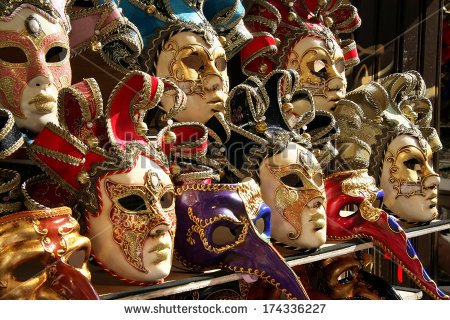
In Venice care was taken to be sure that the archivist was either blind or illiterate so he could not read the files, unlike Connie in the John Le Carré Cold War novels. The files might be sequestered but Connie knew what was in them despite the sealing wax. The files might be altered but Connie forgot nothing. Corporate memory resided in one sodden pensioner.
That passing mention of Padua reminded me that Venice has another connection with Machiavelli. Cardinal Reginald Pole who broke with Henry VIII spent an exile in Padua where he became aware of Machiavelli’s ‘The Prince’ and wrote a condemnation of it, though it is doubtful he read it. Since King Henry’s confident Thomas Cromwell had earlier spent time in Italy, Pole supposed that he learned his sins from Machiavelli. Association is poor proof of cause and effect, but this tenuous thread is woven into Hilary Mantel’s Tudor novels.
Today Venice remains a city of trade, and its trade is with tourists who come to it as if the whole city is a continuous exposition. Venice remains an entrepôt and the product it mow sells is itself. The tourist Venice, the Venice a tourist sees is Venice, he concludes.
While Ackroyd’s impressionistic tour refers to the mysteries and crimes of Venice the dedicated krimi reader turns to Donna Leon for detail.
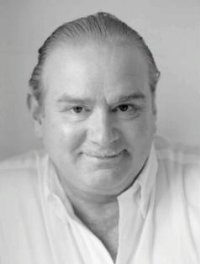 Peter Ackroyd from the dust jacket.
Peter Ackroyd from the dust jacket.
This book is all trip and no arrival. It meanders here and there and Ackroyd is a superb cicerone.
